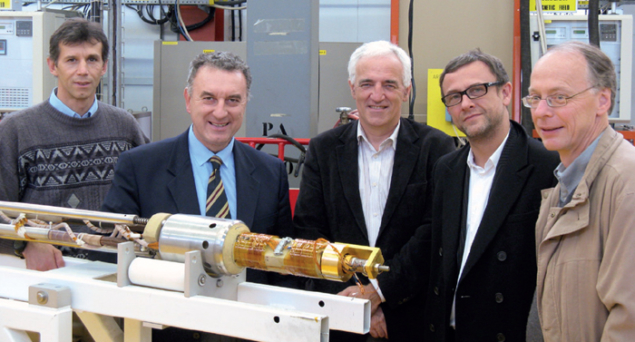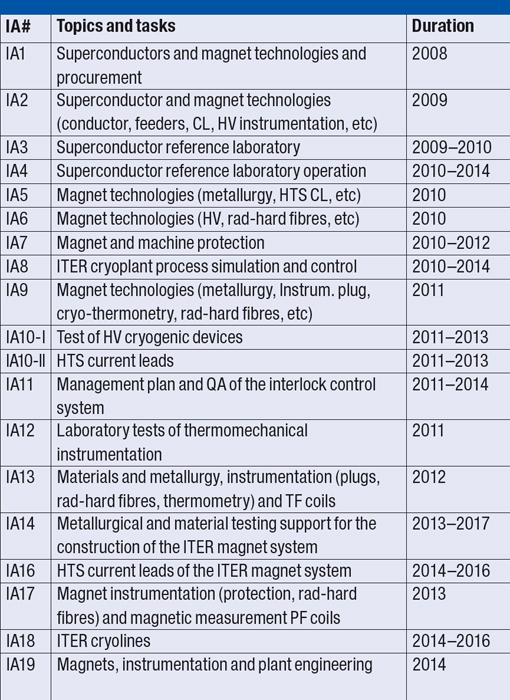The LHC and ITER project share many technologies, providing a natural basis for collaboration.

Image credit: CERN-HI-0803002-01.
In November 2006, the last LHC dipole and quadrupole cold masses arrived at CERN, signalling the end of the industrial construction of the major components of the new 27-km particle collider (CERN Courier October 2006 p28 and January/February 2007 p25). The LHC then entered the installation and the commissioning phases. In the same month, at the Elysée Palace in Paris, the ITER Agreement was signed by seven parties: China, the EU, India, Japan, Korea, Russia and the US. The agreement’s ratification on October the following year marked the start of a new mega-science project – ITER, standing originally for the International Tokamak Experimental Reactor – that in many respects is the heir of the LHC. Both machines are based on, for example, a huge superconducting magnet system, large cryogenic plants of unmatched power, a large volume of ultra-high vacuum, a complex electrical powering system, sophisticated interlock and protection systems, high-technology devices and work in highly radioactive environments.
The two projects share many technologies and operating conditions and are both based on large international collaborations. These elements constitute the basis for a natural collaboration between the two projects, despite there being distinct differences between their managerial and sociological models.

Image credit: CERN-ITER.
In the years 2007–2012, CERN could not engage in new large projects, not only because effort was focussed on installation and commissioning of the LHC – and repair and consolidation (CERN Courier April 2009 p6) – but also because of budgetary constraints set by the repayment of loans for its construction. Many groups and departments at CERN faced a related reduction of personnel. In contrast, the new ITER organization had to be staffed and become immediately operational to organize the procurement arrangements between ITER and the domestic agencies acting for the seven members. Indeed, some new staff members were recruited from laboratories that had just finished their engagement with the LHC, such as the CEA in France and CERN itself. However, the number of staff, compounded by the need to train some of them, was not sufficient to satisfy ITER’s needs. For example, the ITER magnet system – perhaps the largest technical challenge of the whole project – required many further detailed studies before the design could be brought to sufficient maturity to allow hand-over to the domestic agencies for construction. The ITER magnet management was also interested in benefitting from the technical skills and project-management experience for large-scale procurement from industry that CERN had accumulated during construction of the LHC.
In addition to the primary reasons for collaboration between CERN and ITER, there were additional reasons that made it interesting to both parties. For CERN there was the possibility of conducting R&D and studies in key domains, despite the lack of new projects and internal funding. Examples include:
- – the superconductor reference laboratory, set up for the ITER organization, which has proved to be useful for CERN’s internal programme, formally launched in 2011, for the new High Luminosity LHC;
- – qualification of new commercial nuclear-radiation-hard optical fibres, with measurements also at cryogenic temperatures;
- – design of high-temperature superconductor (HTS) 70-kA-class current leads, with sophisticated 3D simulations and experimental mock-ups;
- – setting up a unique high-voltage laboratory for cryo-testing insulation and instrumentation equipment;
- – new concepts and controllers for the HTS current leads and magnet protection units; and
- – activities in metallurgy, welding and material testing, which have helped to increase CERN’s already world-renowned competence in this domain.

The list could be longer. Only a minor part of the activity was supplying a “service” or the transfer of knowledge. In many cases the activity was new design, new R&D or validation of beyond-state-of-the-art concepts.
For ITER, the benefit lay not only in receiving the services and studies, for which it paid. It was also in having access to a large spectrum of competence in a single organization. CERN could react promptly to the demands and needs stemming from contracts and unexpected difficulties in the multiparty complex system set up for ITER construction.
Discussions between CERN and ITER management started in 2007 and were formalized with a framework co-operation agreement signed at CERN by the director-generals of the two organizations on 6 March 2008. This agreement foresaw a co-ordination committee that was in fact not set up until 2012, and has met only twice so far, because the collaboration is working so smoothly that no issues have been raised. The collaboration was then implemented through contracts, called implementing agreements (IAs) to the co-operation agreement. Each IA contract details the specific content, goals, deliverables, time duration and resources.
Table 1 lists the 18 IAs signed so far between CERN and ITER. Each year from 2008, an IA was signed according to the needs of ITER and the possibilities and interest at CERN. Standard annual IAs span one calendar year and contain a variety of different tasks – these are annual IAs. However, IAs with extended durations of up to five years soon became necessary to secure long-term service by giving CERN the possibility of hiring new personnel in excess of those allowed by the internal budget. In total, CERN has had eight annual contracts so far, one short-term contract (IA12) and nine multiyear contracts, two of them lasting five years – one for operation of the superconductor reference laboratory (IA4) and one for metallurgy and material testing for the magnet system (IA14).

As already mentioned, the Co-ordination Committee was not set up until 2012, so the various agreements were overseen by a Steering Committee – later renamed the Technical Committee to distinguish it better from the Co-ordination Committee – which is composed of two members per party. The membership of these committees has been relatively constant and this continuity in management, with smooth changes, is probably one of the reasons for the success of the collaboration. Also, some IAs started outside the usual entry points and were later adjusted to report inside the framework. The CERN-ITER collaboration is a textbook case of how managing relations between complex organizations that are at the centre of a network of institutes is an endless job.
The steering and technical committees meet twice a year and each session is prepared carefully. The committee members review the technical work and resolve resource problems by reshuffling various tasks or setting up amendments to the IAs – which has happened only five times and never for extra costs, only to adjust the execution of work to needs. Long-term planning of work and of future agreements is done in the meetings for the best use of resources, and problems are tackled at their outset. So far, no disputes, even minor ones, have occurred.

Image credits: B Bordini and E Seiler; A Vergara/ITER; S Sgobba and S Langeslag; A Ballarino and B Bordini; D Ricci and E Guillermain; R Lopez, D Tommasini and J Kosek.
As in any sustainable collaboration, there are deep discussions on the allocation of resources, most being personnel related, with only a minor part being about consumables. Figure 1 shows the budget that was allocated for the execution of the agreement. The total of more than CHF14 million engaged corresponds approximately to 80–90 full-time equivalent years used by CERN to fulfil the agreement. Most personnel are CERN staff, in some cases recruited ad hoc, but fellows and associated personnel are also involved.
The examples in figure 2 show a few of the most important technical achievements. One of the key ingredients of the success of the CERN-ITER collaboration is that checks are done on deliverables, rather than on detailed accounting or time-sheet reporting. This has been possible because of the technical competence of both the management and the technical leaders of the various tasks, as well as of the personnel involved, on both sides. Goals and deliverables, even the most difficult ones, were evaluated correctly and reasonable resources allocated at the outset, with a fair balance and good appreciation of margins. This leads to the conclusion that – despite modern management guidelines – technical competence is not a nuisance: it can make the difference.








1 Comment